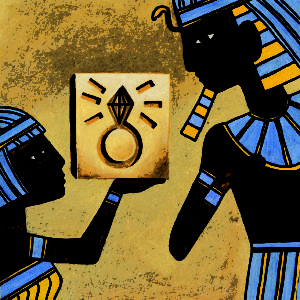Historically Speaking: Women Who Popped the Question
Tradition holds that women only propose marriage on leap days, but queens have never been afraid to take the initiative.
February 20, 2020

ILLUSTRATION: THOMAS FUCHS
An old tradition holds that every leap year, on Feb. 29, women may propose marriage to men without censure or stigma. Sources disagree about the origin of this privilege. One attributes it to St. Brigid, who became concerned for all the unmarried women in 5th-century Ireland and persuaded St. Patrick to grant them this relief. Another gives the credit to Queen Margaret of Scotland, who supposedly had the custom written into Scottish law in 1288.
Neither story is likely to be true: St. Brigid, if she even existed, would have been a child at the time of St. Patrick’s death, and Margaret died at the age of 7 in 1290. But around the world, there have always been a few women who exercised the usually male privilege of proposing.
In the Bible, the widowed Ruth, future great-grandmother of King David, asks her kinsman Boaz to marry her—not with words but by lying down at the foot of his bed. On the Bissagos Islands off the coast of Guinea-Bissau, women propose by offering the man of their choice a ceremonial dish of fish marinated in palm oil.
Queen Ankhesenamun of Egypt, who lived in the 14th century B.C., is believed to have made the earliest recorded marriage proposal by a woman. Based on a surviving letter in the Hittite royal archives, scholars have theorized that Ankhesenamun, the widow of the boy king Tutankhamun, secretly asked the Hittite king Suppiluliuma to agree to a match with one of his sons, so that she could avoid a forced marriage to Ay, her late husband’s grand vizier. The surprised and suspicious king eventually sent her his son Zannanza. Unfortunately, the plan leaked out and the Hittite wedding party was massacred at the Egyptian border. Ankhesenamun disappears from the historical record shortly after.
The Roman princess Justa Grata Honoria, sister of Emperor Valentinian III, had marginally better luck. In 450 she appealed to Attila, King of the Huns, to marry her, in order to escape an arranged marriage with a minor politician. When Valentinian learned of the plan, he refused to allow it and forced Honoria to wed the senator. In retaliation, Attila launched an attack against Rome on the pretext of claiming his bride, capturing Gaul and advancing as far as the Po River in northern Italy.
The idea that marriage was a sentimental union between two individuals, rather than an economic or strategic pact between families, gained ground in Europe in the late 18th century. Jane Austen highlighted the clash of values between generations in her 1813 novel “Pride and Prejudice”: Lady Catherine de Bourgh insists that her daughter and Mr. Darcy have been engaged since birth, while the heroine Elizabeth Bennet declares she will have Darcy if she wants.
Two decades later, a 20-year-old Queen Victoria came down on the side of love when she chose her cousin Albert to be her husband. As a ruling monarch, it was Victoria’s right and duty to make the proposal. As she recorded in her diary on October 15, 1839, “I said to him … that it would make me too happy if he would consent to what I wished.” The 21-year marriage was one of the most successful in royal history.
Although it’s still the custom in most countries for men to propose marriage, leap year or not, there’s more to courtship than getting down on one knee. As the Irving Berlin song goes, “A man chases a girl (until she catches him).”
